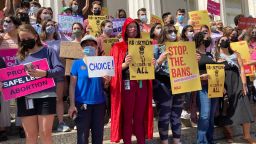The class of public high school seniors who receive their diplomas this June will be the first one ever in which kids of color make up a majority of the graduates, according to federal projections. By the second half of this decade, the federal government projects, those non-White young people will soar to about 55% of the nation’s public high school graduates, meaning they will likely constitute the majority of kids completing 12th grade through the foreseeable future.
Even as this momentous transition is unfolding, the Republican-appointed majority on the Supreme Court recently accepted two cases for its next session that it may use to ban or severely restrict the use of affirmative action to increase the share of minority students admitted to colleges and universities.
Precisely as young people of color are positioned to become most of the nation’s high school graduates, in other words, the court’s GOP-appointed majority may hobble or even bar any effort to bolster their representation in the elite higher education institutions that serve as critical gatekeepers in apportioning opportunity across American society.
That coincidental, but revealing, convergence of legal and demographic change captures the core conflict that Ketanji Brown Jackson, the incoming Supreme Court justice the Senate confirmed last week, will both inherit and sharpen.
On issues from voting rights to abortion, affirmative action, climate change and religious exemptions from civil laws, the Supreme Court’s majority of Republican-appointed justices appears poised to issue a succession of rulings that enshrine into law the values and priorities of the older, culturally conservative White voters at the core of the modern GOP coalition. On all of those issues, and others, the GOP-appointed court majority is likely to repeatedly rule against not only the policy preferences but also in many ways the core identities of Americans who are younger, more racially diverse, less inclined to affiliate with any religious tradition and more likely to identify as LGBTQ.
Once Jackson, the first Black woman confirmed to the court, replaces Justice Stephen Breyer later this year, all three of the Democratic appointees on the court will be women, two of them women of color. They will face off against a GOP majority that comprises four White men, one White woman and one African American man. With that stark alignment in place, the demographic divisions between the two blocs on the court will more closely resemble the divide between the groups of Americans likely to gain, and lose, from the court’s rulings themselves. The court’s internal and external fault lines will more nearly converge.
“We will have this very clear visual of a group of White people trying to rip away rights from Black and brown people while sitting across from Black and brown people with more qualifications than them,” argues Rashad Robinson, president of Color of Change, a leading racial equity organization. “It will be the kind of images we have seen in our civil rights movies and seen in our civil rights books,” he adds, the same sort of history “that their base is trying to ban” through the multiplying red-state laws restricting how public school teachers can discuss current and historic racial discrimination.
The past colliding with the future
Just 51 years old, Jackson will likely spend decades at the center of the gathering conflict between the deeply conservative inclinations of the GOP-appointed justices and the preferences of a diversifying America, particularly the massive millennial and Generation Z cohorts born since 1980, which constitute the most racially and culturally diverse generations in American history.
Some close observers are optimistic that the presence of the first Black female justice may change the court’s internal dynamics in ways that moderate the majority’s approach.
“The fact that we have other justices that appear to be diametrically opposed to her does not prevent them from listening to what she has to say,” Janette McCarthy Wallace, the general counsel at the NAACP, told me. “I can’t say specifically about what they are going to do, but I would like to believe that a woman with such impeccable credentials, with a wealth of experience, both life experience and judicial experience, is a voice that will resonate with all the justices no matter what political background they may represent.”
Still, most advocates for liberal causes are bracing for the GOP-appointed majority to enable the broad drive underway in red states to retrench an array of previously guaranteed civil rights and liberties (such as voting, abortion and LGBTQ rights) while simultaneously constricting the federal government’s ability to act through regulation or executive orders. Jackson, like the other Democratic appointees, is likely to spend years on the defensive as the court becomes a central – perhaps the central – arena for the struggle over control of the country’s direction between the older predominantly White generations key to the GOP coalition and the younger non-White generations that constitute an increasing share of the Democratic electorate.
“In terms of a progressive view of the world, what the Supreme Court is about to do is apocalyptic,” predicts Paul Butler, a professor at the Georgetown University Law Center. “We are about to see not just a judicial attack, but a judicial war.”
The six-member Republican-appointed Supreme Court majority may be only in the early stages of that campaign. Justices Clarence Thomas and Samuel Alito, its oldest members, are just 73 and 72, respectively; absent a health issue, that means this majority couldo remain the ultimate arbiter of the nation’s laws for as much as another decade.
Over that same period, the nation will grow vastly more diverse on every possible dimension. The millennial generation, generally defined as those born between 1981 and 1996, was the most racially and culturally diverse generation in American history – at least until Generation Z, the young people born from 1996 until around 2014. Recent analysis has found that nearly half of Generation Z are kids of color, more than one-third consider themselves unaffiliated with any religious tradition and about one-fifth identity as LGBTQ. Young people born after 2014 will be the United States’ first ever “majority minority” generation, according to recent findings by Bill Frey, a demographer at Brookings Metro, a think tank.
These younger generations are inexorably supplanting the preponderantly White baby boom and older generations in American society. Frey has calculated that millennials and younger – the Americans born since 1980 – recently became the majority of the nation’s population, a historic tipping point. Change, of course, comes more slowly to the electorate, but even there, the nonpartisan States of Change project has forecast that millennials and Generation Z will reach nearly 45% of eligible voters in 2024, exceeding baby boomers and older adults on that metric for the first time. At that point, millennials will represent the largest single generation in the electorate. (Generation X, those born between 1965 and 1980, will remain constant at about one-fourth of eligible voters, roughly their share since 2012.)
Cases ripe for conflict
The Supreme Court’s docket is crowded with cases that threaten the priorities of those younger generations. In the latest CNN/SSRS national survey, for instance, more than three-fourths of younger adults said they supported legalized abortion, but the GOP-appointed majority appears ready, in a case involving a Mississippi law, to overturn Roe v. Wade and rescind or significantly retrench the 50-year-old nationwide right to the procedure. Also in this year’s session, the majority is expected to severely restrict the Environmental Protection Agency’s ability to regulate carbon emissions – even as polls show younger generations expressing elevated concern about climate change.
More cases with stark generational implications are coming. For next year, the court has already agreed to hear cases on admissions policies at Harvard University and the University of North Carolina that could end the use of affirmative action. The court has also agreed to hear another case that could further restrict use of the Voting Rights Act to combat racial gerrymandering in the drawing of congressional districts – this comes after the GOP-appointed majority has issued repeated rulings over the past decade weakening the law in other ways. Also on tap for next year, at a time when more young people than ever are unaffiliated with any religious tradition, is a case that will again explore whether businesses can claim religious objections to serving same-sex couples.
Beyond these cases, the court over the next few years will confront a succession of disputes over the ferocious push now underway in Republican-controlled states to roll back a broad array of civil rights and liberties. Since President Joe Biden’s election, the 23 states where Republicans control both the state legislature and governorship have moved aggressively to restrict access to voting; to ban abortion; to bar transgender girls and women from participating in school sports and to prohibit medical professionals from providing gender-affirming care for minors, even when their parents support it; to censor how teachers can discuss race, gender and sexual orientation in the classroom; to make it easier for critics to ban books in school or even public libraries; and to increase criminal penalties for disruptive public protest. Opponents have already filed federal lawsuits against almost all of those policies, meaning that the Supreme Court may ultimately decide how many of them will stand.
Even that doesn’t represent the outer boundary of cultural disputes flowing toward the court. During Jackson’s confirmation hearings, Republican senators suggested the court had erred in earlier rulings striking down state prohibitions against same-sex marriage (Sen. John Cornyn of Texas), the sale of contraception (Sen. Marsha Blackburn of Tennessee) and even interracial marriage (Sen. Mike Braun of Indiana). In particular, Cornyn’s repeated likening of the court’s 2015 Obergefell ruling creating a nationwide right to same-sex marriage to the notorious 1896 Plessy v. Ferguson case authorizing racial segregation struck many observers as a virtual invitation for a red state to pass legislation testing whether the Supreme Court will reverse its 2015 decision.
Butler says the court’s GOP majority has already sent states a clear signal to test the boundaries on many fronts by refusing to block the Texas law allowing private lawsuits against those involved in providing abortions after early cardiac activity is detected, which can be as soon as six weeks into pregnancy. Because the Texas law “is in open defiance of case law, I think the response that some people might have been expecting even from this court might have been, ‘Oh, hell no, now you’ve gone too far,’” he says. “But that wasn’t the response of the court. The court is pretty much treating that case like any other case, and so it’s an invitation for state lawmakers who are looking on to see what else they can get away with, and what else they can get the court to reconsider.”
Consensus builder – or sharp dissenter?
In polling by the nonpartisan Public Religion Research Institute, Americans younger than 40 express views far more liberal than those of most Republicans – especially those who also identify as White evangelical Christians – on virtually every cultural and civil rights issue imaginable, from abortion to whether immigrants threaten or benefit American society to requiring transgender people to use the bathrooms of the sexes they were assigned at birth to whether police killings of black men are isolated incidents or part of a systemic pattern, according to previously unpublished results provided to CNN. On most of the cultural disputes it is deciding, the court majority “is clearly going against the tide of general public opinion,” especially among the young, says Robert P. Jones, the institute’s founder and CEO.
Jackson will now find herself in the center of all these disputes, probably for decades (though she has said she will recuse herself from the case involving Harvard because of her position on its board of overseers). But exactly how she will use that position remains to be seen. Many observers considered Breyer primarily an inside player who focused more on trying to moderate the opinions of his more conservative colleagues through quiet negotiation than on excoriating their decisions through sharp public dissents, as Justice Sonia Sotomayor has been more inclined to do.
Many of Jackson’s supporters see her as well suited for that role of internal diplomat. The NAACP’s Wallace, for instance, says the “voice of a Black woman in the room” could change the court’s deliberations.
“One thing that everyone has said about her – even those who may have been critical – is that this is a consensus builder and she builds relationships,” she told me. “It’s clear that the court has become increasingly more conservative in its view, but I don’t want to presume that any justice cannot be moved. I don’t want to presume that her voice will be meaningless.”
Yet Butler is one of many court watchers who believe that opportunities to persuade two GOP-appointed justices to abandon the conservative majority will be very rare. More often, he says, the primary task for the Democratic-appointed justices will be to try to raise public awareness about the stakes of the majority’s decisions through stinging dissents. In those cases, he says, “you’ve got to go hard. You are writing in part for history.”
What’s clear already is that the conservative court majority has put itself on a trajectory for rising conflict with the racially and culturally diverse younger generations moving to adulthood. Like the red states passing new restrictions on abortion, voting, LGBTQ rights and classroom teaching, the court’s rulings could have the effect of cementing into law the priorities and preferences of older White Christian conservatives – exactly as more diverse younger generations pass them to become the majority in American society. The GOP-appointed justices, argues Robinson, “are trying to take us back to a time when only certain people could participate in this democracy.”
In this twin-barreled offensive from conservatives in the states and on the court, Jones sees an echo of the campaign by Southern conservatives during the 1920s to build monuments to the confederacy just as the last of those who had fought the war died off. Now, as then, he argues, a passing generation is working to entrench its worldview by systematically erecting barriers against the competing perspectives gaining strength in younger generations.
“It is literally about locking things in place,” Jones told me. In each case, he says, the common goal for older conservatives is “to imprint the culture and the community with our worldview in a way that is very hard to undo. We had that with the Daughters of the Confederacy in granite and bronze and we have that with the current GOP with (state) laws and Supreme Court rulings that might take a generation to undo.”







